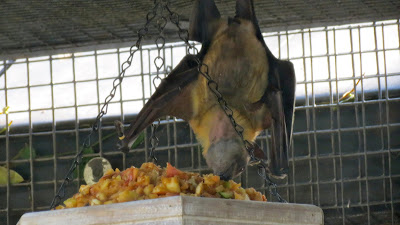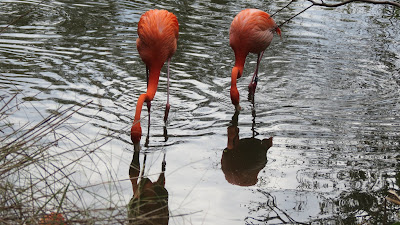It has not been all that many years since it was discovered that not only does this animal attack with its sharp teeth and claws, but that it has ducts between its teeth that contain highly toxic venom that severely weakens its victim until the lizard can leisurely catch up to finish it off and consume it. It was previously thought that it was all the bacteria that can be found in its mouth that was the source of the blood poisoning.
Sunday, March 31, 2013
Living "Dinosaur"
Before going into the dinosaur exhibit at the Jacksonville zoo, we spent a bit of time watching in wonder at the Komodo dragon pen.
They can grow to ten feet long and weigh 300 pounds. Until World War I, most of the world had considered its existence to be a myth.
Saturday, March 30, 2013
Jurassic Jacksonville
The latest attraction at the Jacksonville Zoo is a dinosaur exhibit.
Here are some shots:
We have seen roaring robotic dinosaur exhibits inside museums, but this one being outside, added new realism. The problem we had with it was that it did not appear finished. At least, let's hope not. But I am afraid the industrial junk (such as oil drums, iron gates and wire) may have been planned as part of the exhibit. It just didn't work for us. It just looked junky and it distracted from the dinosaurs.
What I really liked, besides the dinosaurs, were these:
The huge, iron entry gate:
Even with our complaints about the exhibit, it is all worth the trip to see!
Here are some shots:
Contrary to what you might be thinking, I did not photograph all of the dinosaurs.
We have seen roaring robotic dinosaur exhibits inside museums, but this one being outside, added new realism. The problem we had with it was that it did not appear finished. At least, let's hope not. But I am afraid the industrial junk (such as oil drums, iron gates and wire) may have been planned as part of the exhibit. It just didn't work for us. It just looked junky and it distracted from the dinosaurs.
What I really liked, besides the dinosaurs, were these:
The huge, iron entry gate:
and the cool playground
and the excavating area for kids.
Even with our complaints about the exhibit, it is all worth the trip to see!
Friday, March 29, 2013
A Few Zoo Mammals
There is so much to see at the Jacksonville Zoo. Here are a few of the mammals. This elephant was feeding on hay.
Pretty kitty!
The giraffes came right up for a handout.
These are fruit bats.
And there are lots of primates. Here are just a few shots.
Wednesday, March 27, 2013
Zoo Birds: For Hot and Cold
To celebrate our grandson's first birthday, we joined a family group at the Jacksonville Zoo for a fine day of interesting sights. He loves birds so it was a great place to take him. In one large enclosed area, visitors are invited to feed nectar to some tropical birds.
The Florida native wood storks have a large rookery and come and go as they please, building nests now.
I loved watching the flamingos.
Note the immature one that is still rather brown and white. It is the diet of shrimp and crayfish that creates their bright color.
What a magnificent bill! I have been told that black feathers are stronger and that is why many birds have black wingtips. I wonder if the keratin in the beak is tougher on the end where it is black.
I did not realize that they use it almost upside down for feeding.
Speaking of feathers...
The penguins were a hit, especially with the kids. The coloring of these birds is a better match for rocks and ice and snow and cloudy weather that can be characteristic of their native habitats.
B and I have been to this zoo several times over our decades together. It has grown into quite the attraction.
Tuesday, March 26, 2013
When Iris Eyes Are Smiling...
This iris is the first one to bloom this year. It is hardly Irish, but the pun worked for me for St. Patrick's Day, when I had originally planned to publish this.
We are limited in Florida to growing but a few irises. The name of this one is Miss Saigon and I bought the bulbs at Walmart in a plastic mesh bag. These sat on a shelf for a year or more before I got around to putting them in the ground. They are small, delicate flowers with spindly, little strap leaves but I have found them to be perennial here. They are in a bed of coreopsis and larkspur that are just getting started.
From another angle:
Isn't that just a stunning flower?
Monday, March 25, 2013
Saturday, March 23, 2013
Spring in the Woods
As we drove through the woods, the spring blooms were eye-catchers.
The native azaleas are some of my favorites.
These were actually buds, but they were quite striking.
I am pretty sure this is a crabapple. They are not common in our woods.
Subscribe to:
Comments (Atom)


















































